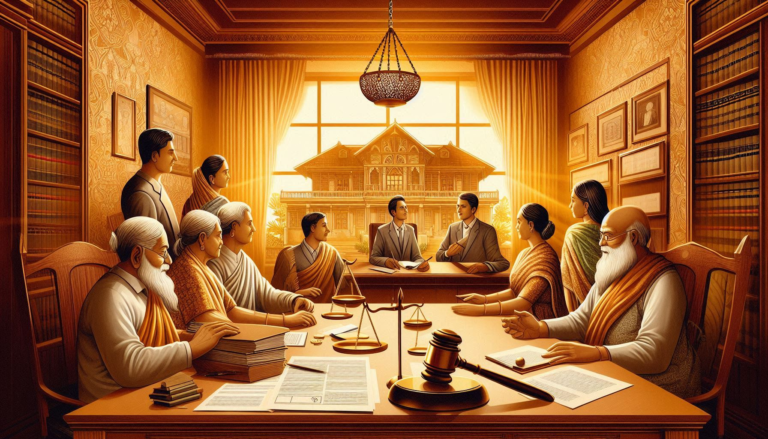
Abstract
Intestate succession in India governs the distribution of property when a person dies without a valid will. The country’s pluralistic framework means different personal laws—Hindu, Muslim, Christian, and Parsi—apply alongside the Indian Succession Act, 1925. This article provides an overview of statutory provisions, judicial interpretations, and customary practices shaping succession rights. It examines gender disparities, legal complexities, and judicial trends that have advanced equality, particularly for women in Hindu law. Challenges such as multiplicity of laws, lack of awareness, and enforcement gaps are highlighted. The article concludes by emphasising legislative reform, legal literacy, and gradual harmonisation to ensure equitable and coherent intestate succession in India.
Introduction
Succession refers to the process by which property devolves upon heirs after the death of a person. In India, succession may occur through a testamentary disposition (where the deceased leaves behind a valid will) or through intestate succession (where the deceased dies without making a will). The latter is more prevalent in India due to the low penetration of testamentary practices across communities. Intestate succession is governed by personal laws, primarily based on religion, with statutory codification in certain contexts.
This article provides a comprehensive overview of intestate succession in India, analysing its legal framework under Hindu Law, Muslim Law, Christian Law, and Parsi Law, along with the Indian Succession Act, 1925, while also reflecting upon judicial interpretations, challenges, and the way forward.
Concept of Intestate Succession
The term “intestate” literally means a person who dies without leaving behind a legally enforceable will. The rules that govern the distribution of such property vary based on religion. Intestate succession covers self-acquired property, ancestral property, and in some cases, joint family property, subject to specific statutory regulations.
The rationale behind intestate succession is to ensure the deceased’s property devolves in an orderly and equitable manner, preventing disputes and uncertainty. Legislation such as the Hindu Succession Act, 1956 and the Indian Succession Act, 1925, play a critical role in regulating such transfers.1
Intestate Succession under Hindu Law
Historical Background
Before codification, Hindu succession was governed by customary practices under the Mitakshara and Dayabhaga schools of Hindu law. These schools differed significantly in the rules of devolution. To bring uniformity, Parliament enacted the Hindu Succession Act, 1956 (HSA), which applies to Hindus, Buddhists, Jains, and Sikhs.2
Scheme of Succession under the Hindu Succession Act, 1956
The HSA establishes a clear hierarchy for inheritance of intestate property:
- Class I Heirs – These include sons, daughters, widow, and mother. Since the 2005 amendment, daughters enjoy equal coparcenary rights with sons.3 Property devolves equally among all Class I heirs.
- Class II Heirs – If no Class I heir exists, property goes to Class II heirs, such as father, siblings, and other relatives.
- Agnates and Cognates – In the absence of Class I and II heirs, property passes to agnates (relatives through male lineage) and then to cognates (relatives through female lineage).
- Escheat to the Government – If no heirs exist, property reverts to the State under the doctrine of escheat.
Key Judicial Pronouncements
In Vineeta Sharma v. Rakesh Sharma (2020)4, the Supreme Court held that daughters have equal coparcenary rights by birth, irrespective of whether the father was alive at the time of the 2005 amendment. This landmark ruling reinforced gender equality in inheritance laws.

Intestate Succession under Muslim Law
Sources of Muslim Inheritance
Muslim succession is largely uncodified and governed by the Quran, Hadith, Ijma, and Qiyas. The two main sects—Sunni (Hanafi School) and Shia (Ithna Ashari School)—have different interpretations, but the fundamental principles remain uniform.
Principles of Muslim Intestate Succession
- Sharers – Certain heirs (like spouse, parents, children) are entitled to fixed shares of the estate.
- Residuaries (Asaba) – After sharers take their portion, the residue goes to residuaries (like sons, brothers).
- Distant Kindred – In the absence of sharers and residuaries, more remote relatives may inherit.
- Doctrine of Radd (Return) – If there is residue left after distribution to sharers and no residuaries, the property reverts proportionately to sharers.
Position of Women under Muslim Law
Though daughters and wives are entitled to inherit, they often receive half the share of their male counterparts. For instance, a son gets double the share of a daughter.5 This reflects patriarchal norms, though justified in Islamic jurisprudence by corresponding financial obligations on men.
Intestate succession under Christian Law
Statutory Framework
Intestate succession for Indian Christians is governed by the Indian Succession Act, 1925. Section 33 of the Act specifies that the widow and lineal descendants are the primary heirs.6
Rules of Distribution
- If the deceased leaves behind a widow and children, the widow gets one-third, while the children equally share the remaining two-thirds.
- If no children exist, but parents survive, the widow takes half and the parents share the rest. If neither children nor parents exist, the widow inherits the entire estate.
- This system provides relatively equitable treatment compared to some other personal laws.
This system provides relatively equitable treatment compared to some other personal laws.
Intestate Succession under Parsi Law
The Indian Succession Act, 1925, also regulates intestate succession among Parsis, with specific provisions in Sections 50-56.
Rules of Distribution
- Both male and female heirs inherit equally, reflecting a progressive approach.
- The widow and children form the primary class of heirs, with parents and siblings considered in the absence of direct descendants.
- A unique feature is that if a Parsi dies without lineal descendants, property is distributed among kindred up to second cousins.7
Role of the Indian Succession Act, 1925
The Indian Succession Act, 1925, consolidates laws relating to succession, applying uniformly to Christians, Parsis, and persons married under the Special Marriage Act. However, it excludes Hindus and Muslims, whose succession is governed by their respective personal laws.
The Act aims at uniformity and codification, laying down elaborate rules for intestate succession, administration of estates, and powers of succession courts.
Special Provisions: The Indian Succession (Amendment) Act, 2002
The 2002 amendment brought significant changes by ensuring that Christian women received equal rights in intestate succession. Earlier, a widow’s share was less favourable compared to that of male heirs, but now she enjoys parity with her male counterparts.8
Comparative Analysis of Succession Laws in India
The comparative analysis of intestate succession laws in India highlights the plurality of legal regimes coexisting within a single jurisdiction. While this pluralism reflects India’s cultural and religious diversity, it also creates inconsistencies and inequalities.
Under Hindu law, the Hindu Succession Act, 1956, particularly after the 2005 amendment, has significantly modernised the law. Daughters now enjoy equal rights as sons in ancestral property, and widows are recognised as Class I heirs, reflecting progressive reforms. However, complexities remain in distinguishing between self-acquired and ancestral property, and disputes often arise in joint families over partition.
By contrast, Muslim law is rooted in classical Sharia and remains largely uncodified. The distinctive feature is that heirs acquire vested rights immediately upon death, and property devolves automatically without the intervention of courts or executors. This ensures certainty but comes at the cost of flexibility. Women are entitled to inherit, but their shares are typically half that of men in similar positions, justified under Islamic jurisprudence by men’s financial responsibility. Critics argue that this framework, while internally consistent, conflicts with constitutional guarantees of gender equality.
Christian succession law, codified in the Indian Succession Act, 1925, adopts a Western model of inheritance. The widow’s rights are prominently safeguarded, and lineal descendants are given priority. The 2002 amendment corrected earlier discriminatory provisions against Christian women, reflecting legislative responsiveness to equality concerns.
The Parsi succession framework, as outlined in the Indian Succession Act, is considered among the most gender-neutral and progressive. Both male and female heirs inherit equally, and even distant relatives are considered eligible heirs, ensuring wide distribution and minimising the possibility of property escheating to the State.
A comparative view thus reveals that while Hindu, Christian, and Parsi laws have benefited from codification and reforms in line with constitutional morality, Muslim succession law remains resistant to statutory reform.9
Judicial Trends in Intestate Succession
The Indian judiciary has played a transformative role in reinterpreting and modernising intestate succession laws, particularly in contexts where statutory reform has lagged.
One of the most significant judicial contributions came in Vineeta Sharma v. Rakesh Sharma (2020)10, where the Supreme Court settled the long-standing ambiguity surrounding daughters’ rights as coparceners. The Court held that the right accrues by birth, not dependent on the father’s survival, and daughters cannot be denied coparcenary status. This landmark judgment overruled the restrictive interpretation in Prakash v. Phulavati (2016)11, which had limited the benefit of the 2005 amendment only to cases where the father was alive post-amendment.
In Danamma v. Amar (2018)12, the Court also ruled in favour of daughters’ coparcenary rights despite the father’s death before the 2005 amendment, reinforcing the commitment to gender justice. Similarly, in Mary Roy v. State of Kerala (1986)13, the Supreme Court struck down the discriminatory provisions of the Travancore Christian Succession Act, thereby ensuring that Syrian Christian women received equal inheritance rights under the Indian Succession Act.
These cases illustrate the judiciary’s willingness to align personal laws with constitutional principles of equality under Articles 14 and 15. By harmonising conflicting provisions, the judiciary has often filled gaps left by the legislature. However, critics caution that judicial activism in sensitive domains like personal law can lead to social backlash, underscoring the need for careful balancing of reform with societal acceptance.
For Muslims, while courts have largely adhered to Quranic mandates, the judiciary has demonstrated a willingness to question discriminatory practices, as reflected in the spirit of Shayara Bano14. Though the case addressed instant triple talaq, its reasoning emphasised gender justice as an essential component of constitutional morality.

Constitutional Perspective
Article 14 (Equality before law) and Article 15 (Non-discrimination) of the Indian Constitution have been invoked to challenge discriminatory succession provisions. The courts have gradually harmonised personal laws with constitutional mandates, though complete uniformity is yet to be achieved.
The debate over the Uniform Civil Code (UCC) often brings intestate succession into focus, questioning whether personal laws should give way to a uniform regime ensuring equality across religions.15
Challenges in the Current Legal Framework
- Gender Inequality: Muslim women still receive unequal shares under Sharia, raising Article 14 concerns; reform faces resistance due to religious autonomy.
- Multiplicity of Legal Regimes: Different personal laws create disputes, especially in interfaith marriages.
- Lack of Awareness: Many die intestate due to cultural hesitation or ignorance about wills, leading to conflicts over property.
- Judicial Burden and Delays: Succession disputes cause lengthy litigation and financial/emotional strain.
- Customary Practices vs. Statutory Law: In rural areas, customs often override laws, limiting women’s inheritance rights.
- Escheat to the State: Property without heirs transfers to the government, but bureaucratic inefficiency hampers utilisation.
Way Forward
- Reform Muslim Succession Law: Ensure gender equality through dialogue and incremental reforms, e.g., equal shares for daughters.
- Promote Testamentary Succession: Encourage will-making via awareness campaigns and simplified registration.
- Judicial and Administrative Efficiency: Fast-track courts and mediation can reduce backlog and preserve family relations.
- Uniform Civil Code (UCC): Phase-in approach focusing on inheritance can promote equality while respecting religious identities.
- Strengthen Women’s Rights Enforcement: Legal aid and state support to help women assert inheritance rights, especially in rural areas.
- Technological Integration: Digitise land/property records and succession certificates to prevent fraud and streamline procedures.
Conclusion
Intestate succession in India is a complex interplay of personal laws, statutory provisions, and judicial interpretations. While reforms in Hindu, Christian, and Parsi laws have advanced gender equality, Muslim law remains largely untouched by statutory reform. The judiciary has consistently moved towards harmonising personal laws with constitutional values of equality and non-discrimination.
However, significant challenges remain—particularly the lack of uniformity, gender biases, and lack of awareness among citizens. The future of intestate succession law in India lies in balancing religious freedom with constitutional morality, potentially paving the way for a uniform yet inclusive system of inheritance.
References
- https://www.indiacode.nic.in/handle/123456789/1542
- https://www.amazon.in/Books-Paras-Diwan/s?rh=n%3A976389031%2Cp_27%3AParas%2BDiwan
- https://www.indiacode.nic.in/handle/123456789/1542
- https://main.sci.gov.in/judgment/judis/45360.pdf
- https://www.amazon.in/Outlines-Muhammadan-Law-Mohammad-Fyzee/dp/0198067906
- https://www.indiacode.nic.in/handle/123456789/2263
- https://www.indiacode.nic.in/handle/123456789/2263
- https://www.indiacode.nic.in/handle/123456789/2263
- https://india.oup.com/product/family-law-volume-1-9780198067900/
- https://main.sci.gov.in/judgment/judis/45360.pdf
- https://main.sci.gov.in/judgment/judis/45360.pdf
- https://www.casemine.com/judgement/in/5b28d7e79eff430f2092c7e4
- https://main.sci.gov.in/judgment/judis/45360.pdf
- https://main.sci.gov.in/judgment/judis/45360.pdf
- https://lawcommissionofindia.nic.in/reports/report259.pdf
Footnotes
- The Hindu Succession Act, No. 30 of 1956, § 8 (India). ↩︎
- Paras Diwan, Modern Hindu Law 432 (22d ed. 2019) ↩︎
- The Hindu Succession (Amendment) Act, No. 39 of 2005, § 6 (India) ↩︎
- Vineeta Sharma v. Rakesh Sharma, (2020) 9 SCC 1 (India) ↩︎
- Fyzee, Outlines of Muhammadan Law 450 (5th ed. 2008) ↩︎
- The Indian Succession Act, No. 39 of 1925, § 33 (India) ↩︎
- Id. §§ 50–56. ↩︎
- The Indian Succession (Amendment) Act, No. 26 of 2002, § 2 (India) ↩︎
- Flavia Agnes, Family Law in India 145 (2016). ↩︎
- Vineeta Sharma v. Rakesh Sharma (2020). ↩︎
- Prakash v. Phulavati, (2016) 2 SCC 36 (India) ↩︎
- Danamma v. Amar, (2018) 3 SCC 343 (India) ↩︎
- Mary Roy v. State of Kerala, (1986) 2 SCC 209 (India). ↩︎
- Shayara Bano v. Union of India. ↩︎
- Law Commission of India, Report No. 259, Uniform Civil Code: A Consultative Paper (2018). ↩︎




